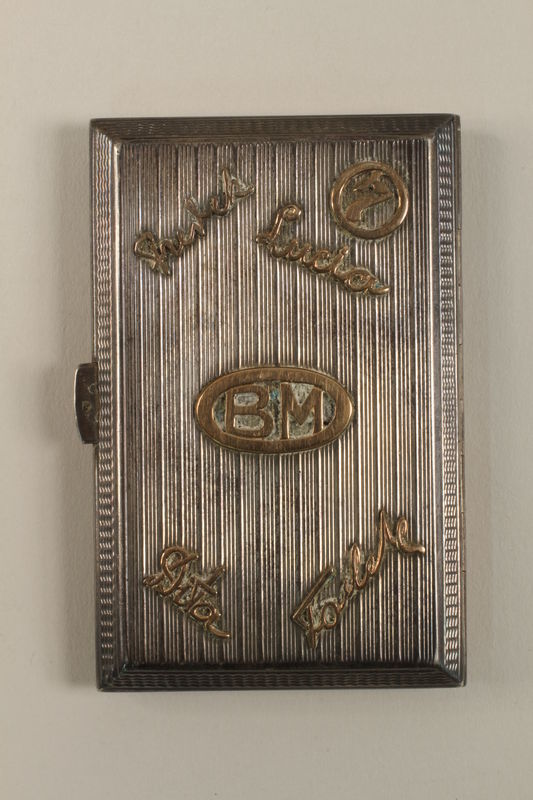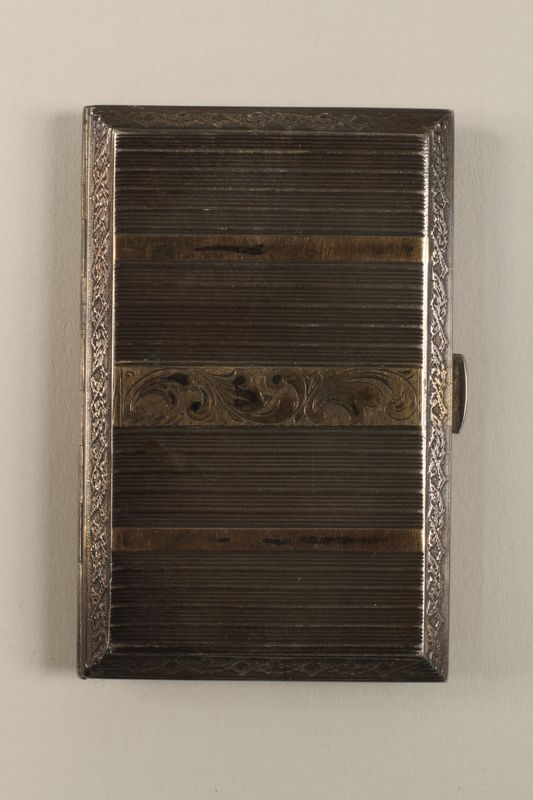Overview
- Brief Narrative
- Cigarette case that belonged to Alfred Majzner, a Jewish engineer, who, following the 1939 invasion of Poland by Germany, fled to the Russian-occupied sector to the east. He was assigned living quarters for his family in Bialystock, Poland, on July 25, 1940. Soon after his wife and family arrived the Russians deported the Jewish inhabitants further west. Alfred died in Kazakhstan in 1942. His second wife and widow, Bronislawa, had the case decorated around 1944 with her initials, BM, and the names of their daughter, Lucia, his children from his first marriage, Dita and Todek, and her deceased, first husband, Fredek. Bronislawa and Lucia returned to Poland when the war ended in 1945 and successfully sued for the return of Alfred's property which had been confiscated during the occupation.
- Date
-
use:
1942-1944
- Geography
-
use:
Chkalov (Soltustik Qazaqstan oblysy, Kazakhstan)
- Credit Line
- United States Holocaust Memorial Museum Collection, Gift of Margareta Kligert
- Contributor
-
Subject:
Alfred Majzner
Subject: Bronislawa Majzner
- Biography
-
Alfred Majzner was born in Kalisz, Poland, in 1887. He was married to Maria-Ruth Tastl, who was from Vienna. They had two children, Edyta (Dita) and Teodor (Todek). Maria-Ruth died of fever soon after Teodor was born in 1918. His second marriage was to Bronislawa. They had a daughter, Lucyna (Lucia), in 1922. Alfred was an engineer in Krakow. In 1938, he bought a plot of land and built a second house in Piotrków Trybunalski, Poland. Teodor went to London to study. During the war, he would join the RAF, but he never returned to Poland. Edyta went to Vienna and Brussels, Belgium, to study fine art. After the Germans invaded Poland in 1939, Alfred, Bronislawa, and Lucia fled east to the Russian-occupied part of Poland. Majzner was assigned an apartment in Białystok, Poland, on January 25, 1940; in March 1941, he was in Archangelsk, Russia. The family was later deported, with the other Jews in the region, to Chkalov, Kazakhstan, where Alfred, 55, died in 1942.
Bronislawa Majzner was married to Alfred Majzner, around 1920. Majzner was her second husband; her first husband, Fredek, was deceased. Majzner was recently widowed, with 2 young children, Dita and Teodor. Bronislawa and Alfred had a daughter named Lucyna (Lucia) in 1922. She owned her own glove shop and Alfred was an engineer in Krakow. In 1938-1939, he bought a plot and built a house for the family in Piotrków Trybunalski, Poland. After the Germans invaded Poland in 1939, Bronislawa, Alfred, and Lucia fled east to the Russian-occupied part of Poland. They were assigned an apartment in Białystok, Poland, on January 25, 1940. The family was later deported, with the other Jews in the region, to Chkalov, Kazakhstan, where Alfred died in 1942, aged 55. After the war, in 1946, Bronislawa and Lucia were awarded title to the house in Piotrków Trybunalski.
Physical Details
- Language
- Polish
- Classification
-
Personal Equipment and Supplies
- Category
-
Smoking paraphernalia
- Object Type
-
Cigarette cases (lcsh)
- Physical Description
- Silver, hinged cigarette case with gold colored detailing and beveled edges. The upper surface has 6 inscriptions attached to the case in gold colored metal; the flat surface is decorated with vertical lines and the border has a wavy line design. The left side of the face has a push button protruding from the center edge. The flat part of the underside is decorated with 3 gold colored bands, a center band with an engraved floral design, and 2 plain bands. The border has a floral lattice design. The interior is lined with gold colored metal. There are 3 small, illegible, maker's marks on either side of the case.
- Dimensions
- overall: Height: 3.125 inches (7.938 cm) | Width: 2.000 inches (5.08 cm)
- Materials
- overall : silver, metal, cloth, rubber
- Inscription
- face, raised gold letters : upper left corner: Fredek
face. raised gold letters : upper right corner: 7 (in a circle)
face, raised gold letters : right corner below: Lucia
face, raised gold letters : center: oval with initials BM
face, raised gold letters : bottom left corner: Dita
face, raised gold letters : bottom right corner: Todek
Rights & Restrictions
- Conditions on Access
- No restrictions on access
- Conditions on Use
- No restrictions on use
Keywords & Subjects
Administrative Notes
- Legal Status
- Permanent Collection
- Provenance
- The cigarette case was donated to the United States Holocaust Memorial Museum in 2009 by Margareta Kligert, the granddaughter of Alfred and Bronislawa Majzner.
- Record last modified:
- 2023-08-31 10:16:06
- This page:
- https://collections.ushmm.org/search/catalog/irn39843
Also in Alfred and Bronislawa Majzner collection
The collection consists of artifacts, documents, and photographs relating to the experiences of Alfred and Bronislawa Majzner in Poland and as refugees in the Soviet Union before, during, and after World War II.
Date: 1940-1945
Margareta Kligert papers
Document
The collection documents the Holocaust experiences of Alfred and Bronislawa Majzner. Included are photographs of Alfred and Bronislawa; a registration book, 1944; request for assignment of an apartment to Alfred in Bialystok, January 25, 1940; envelope sent from Warsaw on March 18, 1941 to Alfred Majzner in Archangelsk, USSR; a postcard addressed to Bronislawa in USSR from Lublin, Poland, dated May 10, 1945; envelope sent from British Embassy in Moscow, to Bronislawa in Kazakhstan (probably contained a letter from Todek Majzner in England).






